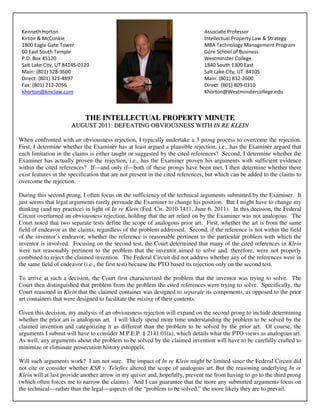
August 2011 Newsletter
- 1. THE INTELLECTUAL PROPERTY MINUTE AUGUST 2011: DEFEATING OBVIOUSNESS WITH IN RE KLEIN When confronted with an obviousness rejection, I typically undertake a 3 prong process to overcome the rejection. First, I determine whether the Examiner has at least argued a plausible rejection, i.e., has the Examiner argued that each limitation in the claims is either taught or suggested by the cited references? Second, I determine whether the Examiner has actually proven the rejection, i.e., has the Examiner proven his arguments with sufficient evidence within the cited references? If—and only if—both of these prongs have been met, I then determine whether there exist features in the specification that are not present in the cited references, but which can be added to the claims to overcome the rejection. During this second prong, I often focus on the sufficiency of the technical arguments submitted by the Examiner. It just seems that legal arguments rarely persuade the Examiner to change his position. But I might have to change my thinking (and my practice) in light of In re Klein (Fed. Cir. 2010-1411, June 6, 2011). In this decision, the Federal Circuit overturned an obviousness rejection, holding that the art relied on by the Examiner was not analogous. The Court noted that two separate tests define the scope of analogous prior art. First, whether the art is from the same field of endeavor as the claims, regardless of the problem addressed. Second, if the reference is not within the field of the inventor’s endeavor, whether the reference is reasonable pertinent to the particular problem with which the inventor is involved. Focusing on the second test, the Court determined that many of the cited references in Klein were not reasonably pertinent to the problem that the inventor aimed to solve and, therefore, were not properly combined to reject the claimed invention. The Federal Circuit did not address whether any of the references were in the same field of endeavor (i.e., the first test) because the PTO based its rejection only on the second test. To arrive at such a decision, the Court first characterized the problem that the inventor was trying to solve. The Court then distinguished that problem from the problem the cited references were trying to solve. Specifically, the Court reasoned in Klein that the claimed container was designed to separate its components, as opposed to the prior art containers that were designed to facilitate the mixing of their contents. Given this decision, my analysis of an obviousness rejection will expand on the second prong to include determining whether the prior art is analogous art. I will likely spend more time understanding the problem to be solved by the claimed invention and categorizing it as different than the problem to be solved by the prior art. Of course, the arguments I submit will have to consider M.P.E.P. § 2141.01(a), which details what the PTO views as analogous art. As well, any arguments about the problem to be solved by the claimed invention will have to be carefully crafted to minimize or eliminate prosecution history estoppels. Will such arguments work? I am not sure. The impact of In re Klein might be limited since the Federal Circuit did not cite or consider whether KSR v. Teleflex altered the scope of analogous art. But the reasoning underlying In re Klein will at last provide another arrow in my quiver and, hopefully, prevent me from having to go to the third prong (which often forces me to narrow the claims). And I can guarantee that the more any submitted arguments focus on the technical—rather than the legal—aspects of the “problem to be solved,” the more likely they are to prevail.